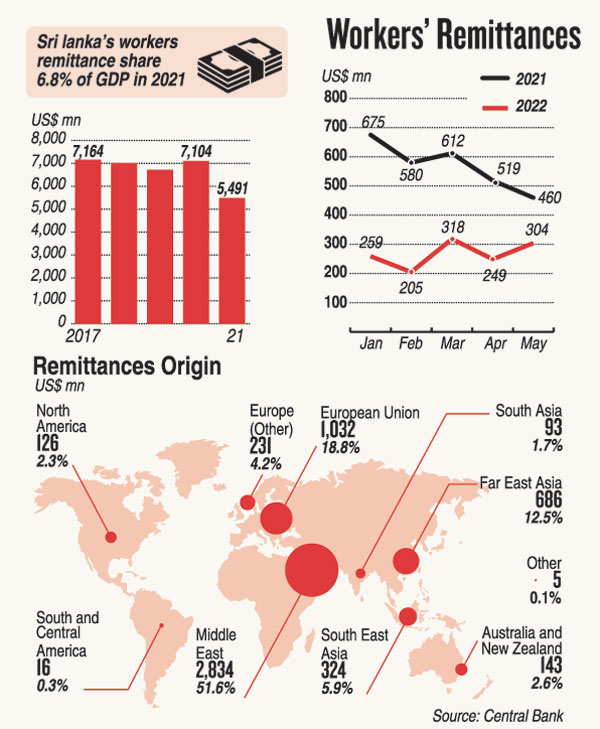News
Foreign earnings from Sri Lankans overseas, exports fluctuate
View(s):By Renishka Fernando
Sri Lankans working overseas have been the biggest contributors of foreign exchange to the country. But their remittances have been declining since 2021.
Data from the Central Bank of Sri Lanka (CBSL) show that remittances from Sri Lankans overseas reached its peak in 2016 at US$7.241 billion. From that year up to 2020, Sri Lankans remitted more than US$7 billion a year, except in 2019 when the remittances were US$ 6.712 billion. 
Remittances fell sharply from 2021 in the period following the COVID-19 pandemic.
“The fixed exchange rate led to this,” said Chayu Damsinghe, the product head of macroeconomic and thematic research at Frontier Research.
With the US dollar exchange rate fixed at Rs 200, remitters started looking at informal markets, he said.
Prior to the fixed exchange rate, the benefits for remitters from the informal system were small and consisted of many loopholes. However, after the fixed exchange rate fiasco, the gains for remitters from informal channels were much higher. “For example, if it was 5 percent more than the exchange rate back then, now it’s 30 – 40 percent higher,” Mr Damsinghe emphasised. The gap between the formal and informal channels increased and using the formal system meant that they would face losses when remitting.
Remittances from Sri Lankans working overseas were US$1.336 billion from January to May. This is down sharply from the US$2.846 billion in the same period of 2021 as shown in CBSL data.
Over the past few weeks, a campaign called ‘Sri Lanka Dollar Challenge’ has started trending on social media as a means of sending much-needed US dollars to Sri Lanka.
Mr Damsinghe said while this may help in the short term, it is not the best solution in the long term.
Meanwhile, a few other important forex-earning sectors, too, are facing a decline.
Central Bank data shows that tourism earnings fell from US$113.3 million in April to US$54.3 million in May. Tourism has been severely affected from 2019 onwards following the Easter Sunday attacks. Tourism hit its peak in 2018 with nearly US$4.40 billion in revenue. Figures from the Sri Lanka Tourism Development Authority (SLTDA) show that while there were over 60,000 arrivals in April, only about 30,200 arrived in May. Compared with May, there has been a marginal improvement in June and July. This situation can be improved if a reasonable solution is found to the fuel issues, said SLTDA. chairman Priantha Fernando.
According to CBSL annual report of 2021, the apparel sector accounts for 5.4 percent of Sri Lankan GDP. The Joint Apparel Association Forum (JAAF) reported that exports have increased by over 39% in comparison to June 2021 as Apparel exports generated US$536 million in June 2022.
“The industry remains hopeful in achieving its export target of US$8 billion by 2025,” JAAF secretary Yohan Lawrence said.
He said apparel manufacturers have initiated welfare schemes for employees — distributing dry rations, providing school books for children, free medical facilities, and special food packages for pregnant women.
The operation of the port in Colombo despite the crisis, has ensured that shipments continued.
Department of Fisheries and Aquatic Resoursces data show that fisheries recorded nearly Rs 46 billion from exports from January to June 2022, with food fish and prawns contributing Rs 28 billion and Rs 6.2 billion, respectively. The industry’s contribution has almost doubled in comparison to the export income in 2021.
“But this could be because of the exchange rate,” said DG Department of Fisheries and Aquatic Resources Susantha Kahawatta. However the sector has been hit by the fuel crisis. Mr Kahawatta said there are 27,000 small boats which need 1 million litres of kerosene a day and 5,200 diesel boats that need 20,000 metric tonnes of diesel a month.
The best way to say that you found the home of your dreams is by finding it on Hitad.lk. We have listings for apartments for sale or rent in Sri Lanka, no matter what locale you're looking for! Whether you live in Colombo, Galle, Kandy, Matara, Jaffna and more - we've got them all!

